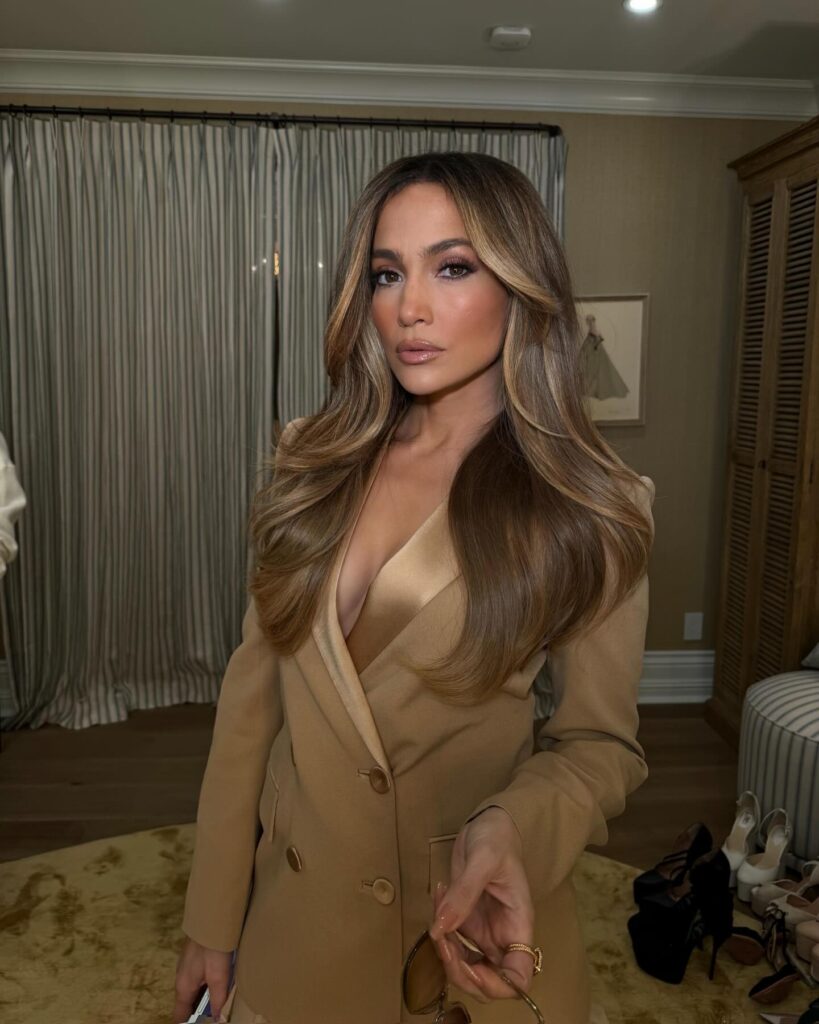
Jennifer Lopez, a prominent figure in the entertainment industry, has long been a voice for change, particularly concerning the portrayal of Latina women in Hollywood.
The Early Struggles of Jennifer Lopez
Lopez’s journey began in the Bronx, where she was raised by Puerto Rican parents.
Fighting Against Stereotypes
In a recent episode of the “Variety Awards Circuit” podcast, Lopez shared her experiences of fighting against the limited roles available for Latina actresses.
She recalled a time when most roles for Latinas were confined to stereotypes, such as maids or store workers.
Lopez’s determination to break these molds was fueled by her belief in herself and her talent.
She expressed frustration at being typecast and longed to play more diverse characters, including romantic leads and relatable figures like the girl next door.
The Importance of Self-Belief
Lopez emphasized the significance of self-belief in overcoming obstacles.
She mentioned how growing up in a challenging environment made her question her place in the industry.
“Sometimes, it’s your responsibility to replace that voice with your own strong voice,” she stated, highlighting the internal struggle many face.
This inner dialogue is crucial for anyone pursuing a career in a subjective field like acting, where criticism can be harsh and pervasive.
The Role of Representation in Media
Lopez’s insights shed light on a broader issue: the need for diverse representation in film and television.
Why Representation Matters
Representation in media shapes societal perceptions and influences how individuals see themselves.
When people, especially young girls, see characters that reflect their own experiences and backgrounds, it fosters a sense of belonging and possibility.
Lopez’s advocacy for varied roles for Latinas is not just about her career; it’s about paving the way for future generations.
Lopez’s Recent Work
In her latest film, “Unstoppable,” Lopez portrays Judy Robles, the mother of one-legged wrestler Anthony Robles.
This role resonates with Lopez, as she identifies with the character’s struggles and aspirations.
“I really understood her,” Lopez said, reflecting on Judy’s journey as a mother and her challenges in life.
This connection to her character further emphasizes Lopez’s commitment to portraying authentic, multi-dimensional women on screen.
The Impact of Jennifer Lopez on the Representation of Latina Women in Hollywood
Jennifer Lopez has been a powerhouse in the entertainment industry for decades.
Her influential career has significantly changed how Latina women are represented in Hollywood.
Early Career Challenges
When Lopez started her career in the late 1980s and early 1990s, Hollywood was less inclusive than it is today.
Limited Roles for Latina Actresses
Latina actresses often faced limited opportunities, frequently being typecast in stereotypical roles such as maids, gardeners, or other minor characters.
Lopez recognized this issue and became determined to break these molds.
She wanted to showcase the richness and diversity of Latina experiences.
Lopez’s Big Break
Lopez’s rise to fame came with the lead role in the 1997 movie “Selena” where she played the iconic Tejano singer Selena Quintanilla.
This role was pivotal for Lopez and for Latina representation in general.
Her performance not only showcased her talent but also offered a more nuanced portrayal of a Latina woman who was complex and relatable.
Shifting Perceptions
Lopez’s success opened doors for other Latina actresses.
Impact on Hollywood
As she became a household name, the perception of Latina women in Hollywood began to shift.
Producers and casting directors started to realize the box office potential of films featuring strong Latina leads.
Lopez’s success story illustrated that Latina actresses could carry a film and draw audiences.
Diverse Roles and Stories
Jennifer Lopez has made a conscious effort to take on diverse roles throughout her career.
She has played everything from romantic leads in films like “Maid in Manhattan” to strong, independent characters in “Enough”.
These varied roles demonstrate the complexity of Latina women and challenge narrow stereotypes.
Advocacy for Representation
Lopez has used her platform to advocate for greater representation of Latinas in the entertainment industry.
Speaking Out
In interviews and public appearances, she has often addressed the systemic challenges faced by Latina actresses.
Lopez emphasizes the importance of telling authentic stories that reflect the realities of Latina women.
Her advocacy has inspired many to call for change in Hollywood’s hiring practices and storytelling approaches.
Collaborations and Productions
Beyond acting, Lopez has also taken on roles as a producer.
Through her production company, Nuyorican Productions, she aims to create and promote content that highlights Latina voices and stories.
This initiative is crucial in the ongoing fight for representation in media.
Cultural Impact
Lopez’s influence extends beyond Hollywood and impacts culture at large.
Role Model for Future Generations
As a successful Latina figure, she serves as a role model for young girls everywhere.
Her visibility has encouraged many to pursue their dreams, despite the obstacles they may face due to their ethnicity.
Lopez’s story shows that success is possible and that representation matters.
Global Influence
Jennifer Lopez’s popularity resonates globally.
Her music and films have reached audiences far beyond the United States, making her a cultural ambassador.
She brings attention to Latina experiences on an international stage, promoting wider acceptance and understanding.
The Challenges Latina Actresses Face in the Film Industry Today
The film industry has made strides toward diversity and inclusion, yet Latina actresses continue to face significant challenges.
These obstacles not only affect their careers but also influence the representation of Latina women in media.
Typecasting and Stereotypes
One of the most persistent challenges for Latina actresses is typecasting.
Limited Roles
Many Latina actresses find themselves confined to specific roles that often rely on stereotypes.
Common portrayals include the fiery Latina, the maid, or the exotic love interest.
These limited roles do not reflect the diverse experiences of Latina women, which can hinder the growth of their careers.
Breaking the Mold
While some actresses, like Jennifer Lopez and Salma Hayek, have successfully broken these molds, many still struggle to find roles that showcase their full range of talent.
This typecasting not only restricts their opportunities but also reinforces harmful stereotypes in society.
Pay Disparities
Another significant challenge faced by Latina actresses is pay disparity.
Gender and Ethnic Pay Gap
Research shows that women of color, including Latinas, often earn less than their white counterparts in Hollywood.
This pay gap can be attributed to several factors, including fewer leading roles and the ongoing prevalence of discrimination.
Economic Impact
Lower pay affects not only the actresses themselves but also their ability to negotiate better roles and opportunities.
This economic disadvantage can make it harder for Latina actresses to sustain long-term careers in an industry that demands financial stability.
Lack of Representation Behind the Camera
The challenges faced by Latina actresses are compounded by a lack of representation behind the camera.
Limited Opportunities for Latina Filmmakers
Fewer Latina directors, producers, and writers means that stories about Latina women are often told from a non-Latina perspective.
This lack of authentic storytelling can lead to misrepresentation and further perpetuates stereotypes.
The Importance of Diverse Voices
Having more Latina voices in decision-making roles is crucial for creating authentic narratives that reflect the realities of Latina lives.
When Latina actresses have input in the projects they work on, it can lead to more meaningful and accurate portrayals.
Cultural Expectations and Pressures
Latina actresses also face cultural expectations and pressures that can affect their careers.
Balancing Identity and Career
Many Latina actresses feel the need to balance their cultural identity with the expectations of Hollywood.
They may struggle with the pressure to conform to certain beauty standards or behaviors that do not align with their authentic selves.
Navigating Dual Identities
This duality can create challenges in finding roles that resonate with their personal experiences while also appealing to mainstream audiences.
Navigating these complexities can be exhausting and may lead to feelings of isolation in the industry.
The Impact of Social Media
In today’s digital age, social media plays a significant role in the careers of Latina actresses.
Visibility and Criticism
While social media can provide a platform for Latina actresses to showcase their work and connect with fans, it also exposes them to criticism and scrutiny.
Negative comments and online harassment can take a toll on their mental health and self-esteem.
Using Social Media for Advocacy
Despite these challenges, many Latina actresses use social media as a tool for advocacy.
They raise awareness about issues affecting their communities and promote positive representation in the media.
This engagement can help shift perceptions and foster a more inclusive environment in Hollywood.
Improving Diversity in Hollywood: How Can Portrayals of Diverse Characters Be Enhanced?
Hollywood has long been criticized for its lack of diversity in storytelling and character representation.
As society becomes more aware of the importance of inclusivity, the film and television industry must take significant steps to improve portrayals of diverse characters.
Understanding the Importance of Diverse Representation
Diverse representation in media is crucial for several reasons.
Reflecting Society
Firstly, the media should reflect the rich diversity of society.
People from various backgrounds, cultures, and identities belong to the world we live in, and their stories deserve to be told.
When audiences see characters that resemble their own experiences, it fosters a sense of belonging and validation.
Improving Diversity in Hollywood: How Can Portrayals of Diverse Characters Be Enhanced?
Hollywood has long been criticized for its lack of diversity in storytelling and character representation.
As society becomes more aware of the importance of inclusivity, the film and television industry must take significant steps to improve portrayals of diverse characters.
Understanding the Importance of Diverse Representation
Diverse representation in media is crucial for several reasons.
Reflecting Society
Firstly, the media should reflect the rich diversity of society.
People from various backgrounds, cultures, and identities belong to the world we live in, and their stories deserve to be told.
When audiences see characters that resemble their own experiences, it fosters a sense of belonging and validation.
Challenging Stereotypes
Secondly, diverse characters help challenge and dismantle stereotypes.
Many cultures have been misrepresented or oversimplified in films and television, leading to harmful misconceptions.
By showcasing well-rounded, diverse characters, Hollywood can educate audiences and promote understanding.
Strategies for Improvement
To enhance the portrayal of diverse characters, the film industry must implement several strategic changes.
1. Inclusive Hiring Practices
Hollywood can start by prioritizing inclusive hiring practices.
Diverse Writer’s Rooms
Having diverse teams of writers, directors, and producers can lead to richer storytelling.
When individuals from different backgrounds contribute their perspectives, the narratives produced are more authentic and varied.
This diversity in storytelling can lead to characters who are not only representative but also complex and relatable.
Expanding Casting Options
Casting decisions should also reflect diversity.
Casting directors must move beyond the practice of selecting “Type A” characters and actively seek actors from different racial, ethnic, and cultural backgrounds.
This approach can result in more diverse and authentic representations on screen.
2. Collaborating with Diverse Creatives
Collaboration with creators from underrepresented groups can significantly enrich projects.
Consulting Cultural Experts
Producers should consult cultural experts to ensure accurate and respectful portrayals of diverse characters.
This practice can help avoid cultural appropriation and ensure that stories are told authentically.
By involving those who have lived the experiences being portrayed, filmmakers can avoid falling into stereotypical traps.
3. Embracing Diverse Storylines
Hollywood should embrace diverse storylines that go beyond surface-level representation.
Sharing Unique Narratives
Instead of relying solely on traditional narratives, filmmakers can explore unique stories that highlight different cultures and experiences.
These narratives can celebrate the richness of human experience and contribute to a deeper understanding of diverse communities.
4. Supporting Female and Minority Directors
Supporting female and minority directors is essential for authentic representation.
New Voices and Perspectives
These directors often bring fresh perspectives that challenge the status quo.
By promoting these voices, Hollywood can provide audiences with diverse stories that reflect their realities and enrich the cinematic landscape.
Overcoming Challenges in the Industry
While many of these strategies are viable, there are challenges within the industry that may hinder progress.
Resistance to Change
Some industry professionals may resist these changes due to traditional views or fear of losing their audience.
However, data shows that diverse films often resonate well with audiences and can be commercially successful.
Importance of Audience Support
Audience demand for diverse stories plays a crucial role in driving change in Hollywood.
When viewers express their interest in seeing more diverse characters and stories, it sends a clear message to studios that these narratives are important.
Successful Examples of Diverse Representation
Several recent films and television shows exemplify how Hollywood can successfully portray diverse characters.
Breaking Bad and Narcos
For instance, series like “Breaking Bad” and “Narcos” portray complex characters from diverse cultural backgrounds, showcasing their experiences without reducing them to clichés.
Black Panther and Crazy Rich Asians
Movies such as “Black Panther” and “Crazy Rich Asians” have demonstrated that diverse casts can lead to blockbuster successes.
These films celebrate their cultures and provide audiences with characters that are multifaceted and relatable.



















